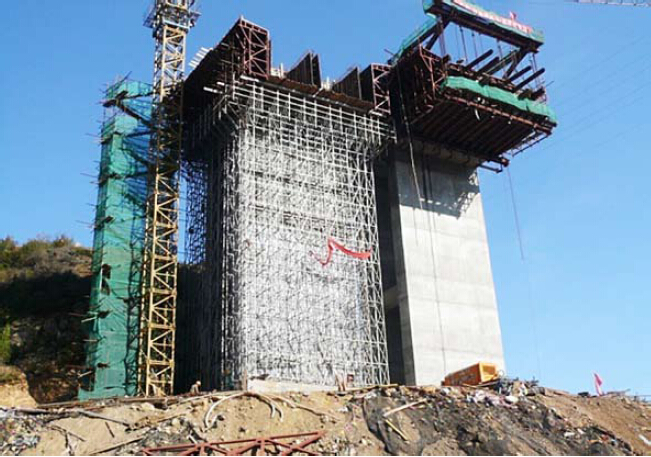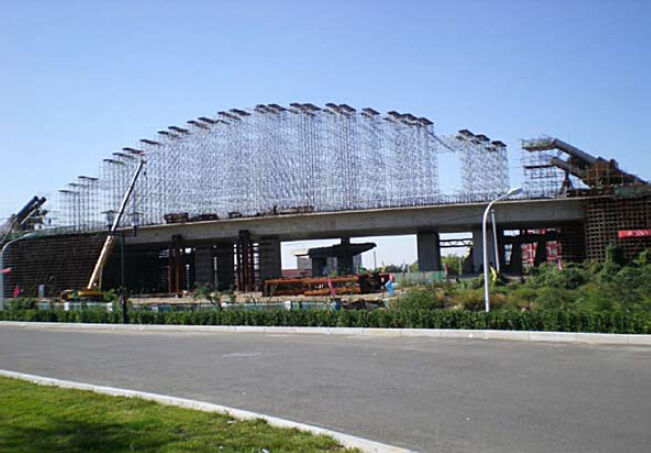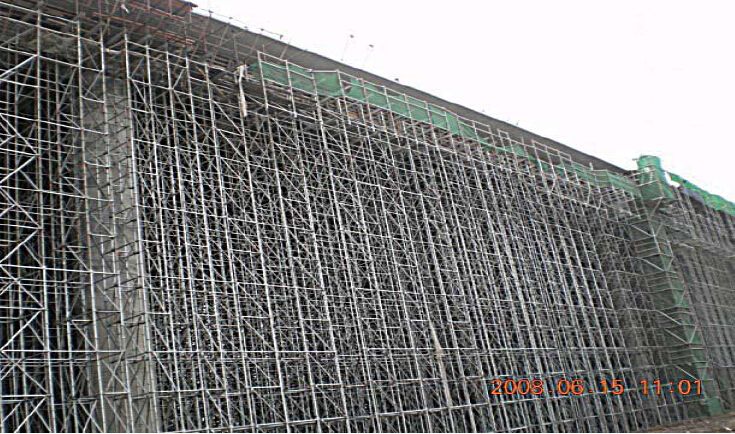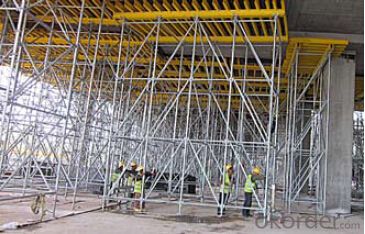Tower Scaffolding for Formwork and Scaffolding systems
- Loading Port:
- Tianjin
- Payment Terms:
- TT OR LC
- Min Order Qty:
- 50 m²
- Supply Capability:
- 1000 m²/month
OKorder Service Pledge
Quality Product, Order Online Tracking, Timely Delivery
OKorder Financial Service
Credit Rating, Credit Services, Credit Purchasing
You Might Also Like
Tower Scaffolding
Shoring tower is an effective supporting system. It is easy to assemble and dismantlement, and
has excellent stability and bearing capacity. It has been widely used in the construction of industry
& residential buildings , bridges, tunnels and dam project, etc.
Characteristics:
◆ High degree of standardization.
◆ Easy storage and transportation


- Q: Can steel formwork be used for curved beams and columns?
- Indeed, curved beams and columns can be constructed using steel formwork. This material possesses flexibility and can be effortlessly molded to accommodate the precise curves and shapes demanded by such structures. Moreover, steel formwork boasts exceptional strength and durability, making it ideal for withstanding the considerable weight and pressure exerted by concrete throughout the construction phase. Furthermore, the utilization of steel formwork enables the accurate and meticulous assembly of curved components, guaranteeing that the end result aligns perfectly with the desired specifications.
- Q: How does steel formwork compare to plastic formwork?
- Steel formwork is generally more durable and long-lasting compared to plastic formwork. It can withstand heavy loads and provides better stability and support during the concrete pouring process. Additionally, steel formwork is reusable and can be easily adjusted and customized according to project requirements. On the other hand, plastic formwork is lighter and easier to handle, making it more suitable for small-scale projects. However, it may not be as sturdy and may require more frequent replacements.
- Q: Can steel formwork be used for industrial construction projects?
- Yes, steel formwork can be used for industrial construction projects. Steel formwork offers several advantages such as durability, strength, and reusability, making it suitable for heavy-duty applications in industrial construction. It provides a stable and rigid structure to support concrete during the casting process, ensuring accurate and high-quality results. Additionally, steel formwork can withstand harsh weather conditions and repetitive use, making it ideal for industrial projects that require long-term and reliable formwork systems.
- Q: How does steel formwork contribute to the fire resistance of the structure?
- Steel formwork, also referred to as steel molds or frames, plays a crucial role in enhancing the fire resistance of a structure. Primarily, steel possesses inherent fire-resistant properties due to its high melting point and low combustibility, making it an optimal choice for formwork in areas prone to fires. When steel formwork is employed in construction, it imparts strength and rigidity to the structure, thereby preserving its integrity during a fire. These steel molds securely hold the concrete in place, preventing its collapse or disintegration when exposed to elevated temperatures. This structural stability enables firefighters to enter the building safely and extinguish the fire without concerns of sudden structural failure. Furthermore, steel formwork acts as a heat sink during a fire by virtue of its high thermal conductivity. This characteristic facilitates the rapid absorption and dissipation of heat, thereby minimizing the spread of fire and reducing the overall temperature within the structure. By absorbing heat, steel formwork effectively delays the occurrence of concrete spalling or cracking, thereby maintaining the structural integrity of the building for an extended duration. In addition, steel formwork is often designed with appropriate fire-resistant coatings or insulation materials. These coatings provide an additional layer of protection against heat, flames, and smoke generated during a fire. They also aid in impeding or slowing down the transfer of heat to the concrete, thereby further augmenting the fire resistance of the structure. Overall, the utilization of steel formwork significantly enhances the fire resistance of a building by providing structural stability, functioning as a heat sink, and incorporating fire-resistant coatings or insulation materials. By incorporating steel molds, architects and engineers can ensure the safety and longevity of the structure, even in the event of a fire.
- Q: What are the common design considerations for steel formwork in high-rise buildings?
- When it comes to designing steel formwork for high-rise buildings, there are several common considerations that need to be taken into account. These considerations are crucial for ensuring the structural integrity, safety, and efficiency of the formwork system. 1. Load capacity: Steel formwork needs to be able to withstand the loads it will be subjected to during the construction process. This includes the weight of the concrete, workers, equipment, and any other imposed loads. The formwork should be designed to have sufficient load capacity to prevent any deformation or failure. 2. Stability: High-rise buildings are subjected to various external forces such as wind and seismic loads. The formwork system needs to be stable and resistant to these forces to prevent any accidents or collapse. Proper bracing, tie-downs, and anchorage systems should be incorporated into the design to ensure stability. 3. Durability: Steel formwork must be able to withstand the harsh conditions of construction sites, including exposure to moisture, chemicals, and physical impact. The material selection and protective coatings should be chosen carefully to ensure long-term durability and prevent corrosion. 4. Flexibility: High-rise buildings often have complex geometries with different floor layouts, wall configurations, and column sizes. The formwork system should be flexible enough to accommodate these variations and allow for easy adjustments and reusability. Modular formwork systems are commonly used to provide this flexibility. 5. Safety: Safety is of utmost importance in high-rise construction. The design of the formwork system should incorporate safety features such as non-slip surfaces, guardrails, access platforms, and fall protection systems. Adequate space for workers to move around and perform their tasks safely should also be considered. 6. Construction timeline: Time is a critical factor in high-rise construction projects. The formwork system should be designed to enable fast and efficient construction, minimizing downtime and delays. This could involve using pre-fabricated components, easy assembly and disassembly methods, and efficient material handling systems. 7. Cost-effectiveness: The design of the steel formwork system should optimize cost-effectiveness without compromising on quality and safety. This includes factors such as material selection, formwork reuse, efficient use of labor, and minimizing waste. Overall, the design considerations for steel formwork in high-rise buildings revolve around load capacity, stability, durability, flexibility, safety, construction timeline, and cost-effectiveness. By carefully addressing these considerations, designers can ensure a successful and efficient construction process for high-rise buildings.
- Q: What are the common design considerations for steel formwork in earthquake-prone areas?
- Some common design considerations for steel formwork in earthquake-prone areas include using strong and ductile materials, such as high-strength steel, to ensure structural integrity during seismic events. The formwork should be designed to withstand lateral forces and vibrations caused by earthquakes, often by incorporating additional bracing and reinforcement. It is also important to consider the connection details between formwork elements to enhance stability and prevent potential failures. Additionally, the design should account for potential ground movement and soil conditions to ensure the formwork remains stable and secure during earthquakes.
- Q: Can steel formwork be used for both large and small-scale construction projects?
- Yes, steel formwork can be used for both large and small-scale construction projects. It is a versatile and durable material that can be easily customized and adjusted to accommodate different project sizes and complexities. Steel formwork provides excellent strength and stability, making it suitable for a wide range of construction applications, regardless of the project scale.
- Q: How does steel formwork handle different concrete surface sealing products?
- Steel formwork is a commonly used material in the construction industry for creating molds or structures to pour concrete into. When it comes to handling different concrete surface sealing products, steel formwork has certain advantages and considerations. Firstly, steel formwork is highly durable and robust, which makes it well-suited to withstand the application of different concrete surface sealing products. These sealing products, such as epoxy coatings, polyurethane sealers, or acrylic sealants, are typically designed to enhance the durability, aesthetics, and resistance of the concrete surface. Steel formwork can handle the application process without getting damaged or compromised. Secondly, steel formwork provides a smooth and even surface for the application of concrete surface sealing products. This is crucial as a proper seal requires an even and consistent application to ensure optimal performance. Steel formwork, when properly constructed and maintained, can provide the necessary level of precision and flatness needed for the successful application of sealing products. However, it is important to note that steel formwork may require additional preparation and precautions when using certain concrete surface sealing products. For example, if a sealing product requires a clean and porous surface for proper adhesion, the steel formwork may need to be treated or roughened to create the desired surface texture. This can be achieved through techniques such as sandblasting or applying a bonding agent. Furthermore, steel formwork should be properly cleaned and free from any residues or contaminants before applying concrete surface sealing products. Any residual concrete, oils, or dirt on the formwork may interfere with the adhesion and performance of the sealing products. Regular maintenance and cleaning of the steel formwork are essential to ensure its compatibility with different concrete surface sealing products. In conclusion, steel formwork is a reliable and sturdy material that can handle different concrete surface sealing products. Its durability, precision, and smooth surface make it a suitable choice for the application of various sealing products. However, additional preparation, maintenance, and cleaning may be required to ensure optimal compatibility and performance.
- Q: What are the common problems encountered with steel formwork?
- Some common problems encountered with steel formwork include rusting or corrosion, damage due to mishandling or improper storage, difficulty in handling and assembling due to its heavy weight, and potential for warping or bending under pressure.
- Q: How does steel formwork contribute to improved construction site logistics?
- Improved construction site logistics can be achieved through the use of steel formwork. One major advantage of steel formwork is its durability and reusability, which eliminates the need for frequent replacement and disposal. This not only saves costs but also reduces waste generation on the construction site. Furthermore, steel formwork is highly adaptable and can be easily customized to meet specific project requirements. This flexibility enables efficient and precise construction, leading to increased productivity and reduced construction time. By streamlining construction site activities, steel formwork simplifies the management and coordination of different tasks. In addition, steel formwork enhances safety on construction sites. Its strong and rigid structure ensures stability during concrete pouring and curing processes, minimizing the risk of accidents or structural failures. This creates a safer working environment for construction workers and reduces the likelihood of delays or disruptions caused by safety issues. Moreover, steel formwork provides better control over the quality of the concrete structure being constructed. Its smooth surface and accurate dimensions enable consistent and precise finishes, reducing the need for rework or corrections. This saves time and reduces material wastage. Lastly, compared to traditional timber formwork, steel formwork is lightweight and easy to handle and transport. This simplifies logistics planning and allows for faster and more efficient movement of formwork components across the construction site. The ease of handling also reduces physical strain on workers, leading to increased productivity and a lower risk of injuries. In conclusion, steel formwork offers durability, adaptability, safety, quality control, and ease of handling, all of which contribute to improved construction site logistics. These advantages result in cost savings, reduced waste, increased productivity, and a safer working environment, ultimately leading to more efficient and successful construction projects.
Send your message to us
Tower Scaffolding for Formwork and Scaffolding systems
- Loading Port:
- Tianjin
- Payment Terms:
- TT OR LC
- Min Order Qty:
- 50 m²
- Supply Capability:
- 1000 m²/month
OKorder Service Pledge
Quality Product, Order Online Tracking, Timely Delivery
OKorder Financial Service
Credit Rating, Credit Services, Credit Purchasing
Similar products
Hot products
Hot Searches
Related keywords

















